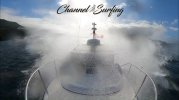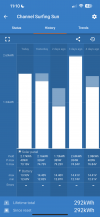The SunSaver duo is a PWM style controller. Just switching to a MPPT style controller (more efficient) will result in 20% more power from sunshine on the existing solar panel you have. The PWM style controllers were really designed for low wattage solar arrays as the PWM controller uses very little power. An MPPT controller also uses little power, but it uses more than a PWM consumes.
Most MPPT controllers that I've seen available only output to a single battery bank. The SunSaver Duo is configured for 90% to the house, 10% to the engine battery. Personally, I don't think this is necessary. On a NW edition boat using all AGM or FLA batteries.. those SI-ACR's, with enough sunshine, a charge voltage is created causing the ACR's to close, which means sunshine will get to all three battery banks. On folks with a Luxury Edition (using LiFePo4 batteries), then the output of the MPPT controller just goes to the house bank. EPever makes a MPPT controller that will send 90% to the house and 10% to the engine battery. This is what's standard on the NW editions today that Fluid Motion is selling on the new boats (A 20amp EPever is what the factory uses today). Again, I don't think it's necessary to have dual outputs (house and engine). It doesn't hurt to have dual-outputs.
When I re-wired Channel Surfing and converted my NW edition to LiFePo4 (LFP), I went with a 100/30 MPPT Victron SmartSolar controller. I've since replaced it with a 100/35 Victron controller. I have two 210 watt solar panels (420 watts total). It serves us well, with no generator on board. My MPPT controller outputs to the House bank and that's it. My thruster and engine battery get charged on shore power or when the engine is running. I figure, my car sitting in my driveway for the 55 days we were gone to SE Alaska, started up fine upon our return. The only use case I can see where maybe having the MPPT controller with dual outputs to the engine and house battery is if we trailered our boat and stored our boat for long periods of time on the trailer without shore power. But then again, if that was storage on a trailer without shorepower, I'd probably bring the engine and thruster battery home to my garage for the off-season.
I also want to note the following. A PWM style controller requires that the voltage of the solar panel match the voltage of the battery bank. Our boat is 12volts, and the original solar panel that came on Channel Surfing was a 12 volt 160 watt panel. The 210 watt panels I put up are 24 volt panels. Larger panels most often are going to be 24volt (some are 48 volt). The MPPT controller is a battery charger, while a PWM controller is more like an on/off switch. Said differently, if you're going to upgrade solar on your boat, always start by upgrading the controller first since it's likely that whatever panel you go with, you'll need a MPPT controller for compatibility with the new panel you put up. I started by upgrading from PWM to MPPT, and 5 months later I did the solar panel upgrade.
I have a ton of info published all about solar on our website.

www.letsgochannelsurfing.com
And also over on YouTube. Here's a playlist of all our "Solar on a Boat" videos.
Share your videos with friends, family, and the world

www.youtube.com
www.letsgochannelsurfing.com



